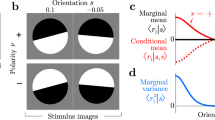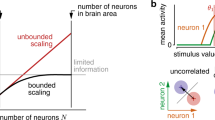Abstract
We derive experimentally based estimates of the energy used by neural mechanisms to code known quantities of information. Biophysical measurements from cells in the blowfly retina yield estimates of the ATP required to generate graded (analog) electrical signals that transmit known amounts of information. Energy consumption is several orders of magnitude greater than the thermodynamic minimum. It costs 104 ATP molecules to transmit a bit at a chemical synapse, and 106 - 107 ATP for graded signals in an interneuron or a photoreceptor, or for spike coding. Therefore, in noise-limited signaling systems, a weak pathway of low capacity transmits information more economically, which promotes the distribution of information among multiple pathways.
This is a preview of subscription content, access via your institution
Access options
Subscribe to this journal
Receive 12 print issues and online access
$209.00 per year
only $17.42 per issue
Buy this article
- Purchase on Springer Link
- Instant access to full article PDF
Prices may be subject to local taxes which are calculated during checkout




Similar content being viewed by others
References
Kety, S.S. in Metabolism of the Nervous System (ed. Richter, D.) 221–237 (Pergamon, London, 1957)
Ames, A. Energy-requirements of CNS cells as related to their function and to their vulnerability to ischemia - a commentary based on studies on retina. Can. J. Physiol. Pharmacol. 70, S158–S164 (1992)
Ames, A. in Mitochondria and Free Radicals in Neurodegenerative Disease (eds Beal, M.F., Howell, N. & Bodis-Wollner, I.) 17–27 (Wiley-Liss, New York, 1997)
Aiello, L.C. & Wheeler, P. The expensive tissue hypothesis: the brain and the digestive system in human and primate evolution. Curr. Anthropol. 36, 199–221 (1995)
Martin, R.D. Scaling of the mammalian brain - the maternal energy hypothesis. News In Physiol. Sci. 11, 149–156 (1996)
Levy, W.B. & Baxter, R.A. Energy-efficient neural codes. Neural Computation 8, 531–543 (1996)
Sarpeshkar, R. Analog versus digital: extrapolating from electronics to neurobiology. Neural Computation (in press, 1998)
de Ruyter van Steveninck, R.R. & Laughlin, S.B. The rate of information-transfer at graded-potential synapses. Nature 379, 642–645 (1996)
Laughlin, S.B. Matching coding, circuits, cells, and molecules to signals - general principles of retinal design in the fly's eye. Prog. Ret. Eye. Res. 13, 165–196 (1994)
Gerster, U., Stavenga, D.G. & Backhaus, W. Na+/K+ pump activity in photoreceptors of the blowfly Calliphora: A model analysis based on membrane potential measurements . J. Comp. Physiol. A. 180, 113– 122 (1997)
Hamdorf, K., Hochstrate, P., Hoglund, G., Burbach, B. & Wiegand, U. Light activation of the sodium-pump in blowfly photoreceptors . J. Comp. Physiol. A. 162, 285– 300 (1988)
Jansonius, N.M. Properties of the sodium-pump in the blowfly photoreceptor cell. J. Comp. Physiol. A. 167, 461–467 (1990)
Tsacopoulos, M., Veuthey, A.L., Saravelos, S.G., Perrottet, P. & Tsoupras, G. Glial-cells transform glucose to alanine, which fuels the neurons in the honeybee retina. J. Neurosci. 14, 1339–1351 (1994)
Beersma, D.G.M., Stavenga, D.G. & Kuiper, J.W. Retinal lattice, visual field and binocularities in flies. J. Comp. Physiol. 119, 207– 220 (1977)
Hardie, R.C. & Minke, B. Phosphoinositide-mediated phototransduction in Drosophila photoreceptors - the role of Ca2+ and trp. Cell Calcium 18, 256– 274 (1995)
Nicol, D. & Meinertzhagen, I.A. An analysis of the number and composition of the synaptic populations formed by photoreceptors of the fly. J. Comp. Neurol. 207, 29– 44 (1982)
Hardie, R.C. A histamine-activated chloride channel involved in neurotransmission at a photoreceptor synapse . Nature 339, 704–706 (1989)
Laughlin, S.B. & Osorio, D. Mechanisms for neural signal enhancement in the blowfly compound eye. J. Exp. Biol. 144, 113–146 (1989)
van Hateren, J.H. & Laughlin, S.B. Membrane parameters, signal transmission, and the design of a graded potential neuron. J. Comp. Physiol. A. 166, 437–448 (1990)
Uusitalo, R.O. & Weckström, M. The regulation of chloride homeostasis in the small nonspiking visual interneurons of the fly compound eye. J. Neurophysiol. 71, 1381– 1389 (1994)
Borst, J.G.G. & Sakmann, B. Calcium influx and transmitter release in a fast CNS synapse. Nature 383, 431– 434 (1996)
Hall, Z.W. An introduction to molecular neurobiology, 555 (Sinauer, Sunderland, Mass., 1992)
Rieke, F., Warland, D., de Ruyter van Steveninck, R.D. & Bialek, W. Spikes - exploring the neural code, 395 (MIT Press, Cambridge, Mass., 1997)
Keister, M. & Buck, J. in The Physiology of Insecta 2nd edn Vol. 6 (ed. Rockstein, M.) (Academic Press, N.Y., 1974)
Aiello, L.C. Brains and guts in human evolution: The expensive tissue hypothesis. Braz. J. Genetics 20, 141–148 (1997)
Diamond, J.M. Competition for brain space. Nature 382, 756– 757 (1996)
Szilard, L. Uber die Entropieverminderung in einem thermodynamischen System bei Eingriffen intelligenter Wesen. Z.Physik 53, 840–856 (1929)
Leff, H.S. & Rex, A.F. Maxwell's Demon: Entropy, Information, Computing, 349 (Adam Hilger, Bristol, 1990 )
Howard, J. The movement of kinesin along microtubules. Ann. Rev. Physiol. 58, 703–729 (1996)
Hua, W., Young, E.C., Fleming, M.L. & Gelles, J. Coupling of kinesin steps to ATP hydrolysis . Nature 388, 390–393 (1997)
Schnitzer, M.J. & Block, S.M. Kinesin hydrolyses one ATP per 8-nm step. Nature 388, 386–390 (1997)
Hille, B. Ionic Channels of Excitable Membranes, 607 (Sinauer, Sunderland, Mass., 1992)
Bray, D. Signaling complexes . Ann. Rev. Biophys. (in press, 1998)
Weckström, M., Hardie, R.C. & Laughlin, S.B. Voltage-activated potassium channels in blowfly photoreceptors and their role in light adaptation. J. Physiol. (Lond.) 440, 635–657 (1991)
Weckström, M., Kouvalainen, E. & Juusola, M. Measurement of cell impedance in frequency-domain using discontinuous current clamp and white-noise-modulated current injection. Pflugers Arch.-Eur. J. Physiol. 421, 469– 472 (1992)
Hardie, R.C. Whole-cell recordings of the light-induced current in dissociated Drosophila photoreceptors - evidence for feedback by calcium permeating the light-sensitive channels . Proc. R. Soc. Lond. B. 245, 203– 210 (1991)
Stuart, A.E., Morgan, J.R., Mekeel, H.E., Kempter, E. & Callaway, J.C. Selective, activity-dependent uptake of histamine into an arthropod photoreceptor. J. Neurosci. 16, 3178–3188 (1996)
Sonders, M.S. & Amara, S.G. Channels in transporters. Current Opinion In Neurobiology 6, 294– 302 (1996)
Schuldiner, S., Shirvan, A. & Linial, M. Vesicular neurotransmitter transporters - from bacteria to humans. Physiol. Rev. 75, 369– 392 (1995)
Laughlin, S.B., Howard, J. & Blakeslee, B. Synaptic limitations to contrast coding in the retina of the blowfly Calliphora. Proc. R. Soc. Lond. B. 231, 437–467 (1987)
Fröhlich, A. Freeze-fracture study of an invertebrate multiple-contact synapse - the fly photoreceptor tetrad. J. Comp. Neurol. 241, 311– 326 (1985)
Skingsley, D.R., Laughlin, S.B. & Hardie, R.C. Properties of histamine-activated chloride channels in the large monopolar cells of the dipteran compound eye - a comparative-study . J. Comp. Physiol. A. 176, 611– 623 (1995)
Meinertzhagen, I.A. & O'Neil, S.D. Synaptic organization of columnar elements in the lamina of the wild- type in Drosophila melanogaster. J. Comp. Neurol. 305, 232–263 (1991)
Acknowledgements
We would like to thank W. Bialek, D. Bray, R. Carpenter, R.C. Hardie, J.H. van Hateren and D.C. O'Carroll for their comments and suggestions, and A. Ames for his encouragement and an excellent introduction to the energetics of neural function.
Author information
Authors and Affiliations
Corresponding author
Rights and permissions
About this article
Cite this article
Laughlin, S., de Ruyter van Steveninck, R. & Anderson, J. The metabolic cost of neural information. Nat Neurosci 1, 36–41 (1998). https://doi.org/10.1038/236
Received:
Accepted:
Published:
Issue Date:
DOI: https://doi.org/10.1038/236
This article is cited by
-
Neuronal dynamics direct cerebrospinal fluid perfusion and brain clearance
Nature (2024)
-
Information encoded in volumes and areas of dendritic spines is nearly maximal across mammalian brains
Scientific Reports (2023)
-
Optoelectronic graded neurons for bioinspired in-sensor motion perception
Nature Nanotechnology (2023)
-
Extending in-sensor computing from static images to dynamic motions
Nature Electronics (2023)
-
Ferroelectric-defined reconfigurable homojunctions for in-memory sensing and computing
Nature Materials (2023)



